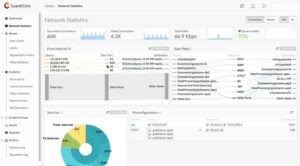The network security evolving constantly with the emergence of new threats and attack techniques. Lets have a look at these three network security products the way they tackle the problem.
In past almost all enterprise cyber security products were centered within the network security category and protecting the back-end servers that ran organizations was everything. Even today, with an increased focus on cloud, virtualization and enterprise-level endpoint security, protecting the core network is still a primary concern for most organizations. Network security is a category that is constantly evolving every day, especially now when new threats and attack techniques continue to emerge. As a result, today we need products designed to enhance network security that can be focused in a lot of diverse ways from gateways and perimeters stationed at the fringes to application level protection wrapped around core programs and functions in the center of a network. We need the products that can employ many unique technologies, from scanning and deception to monitoring, patching and just about everything else in-between.
Lets have a look at some new innovative products that use diverse learning to protect network from new threats.
GreatHorn
 Most email gateway appliances only scan for known bad domains or the presence of malware, “please see attached invoice” “You have a refund from CRA” -type social engineering phishing attacks normally breeze through security. GreatHorn was designed to close that security gap, as well as lock down the rest of the mail stream. The software as a service (SaaS) product exists inside the cloud and works particularly well with Microsoft Azure, where it can run in tandem with a corporate mail server for Office 365 users. But it also works elsewhere too. GreatHorn’s machine-learning approach and data architecture provides unmatched threat detection capabilities, aggregating de-identified data across every customer to improve the accuracy of the threat detection platform for each individual user.
Most email gateway appliances only scan for known bad domains or the presence of malware, “please see attached invoice” “You have a refund from CRA” -type social engineering phishing attacks normally breeze through security. GreatHorn was designed to close that security gap, as well as lock down the rest of the mail stream. The software as a service (SaaS) product exists inside the cloud and works particularly well with Microsoft Azure, where it can run in tandem with a corporate mail server for Office 365 users. But it also works elsewhere too. GreatHorn’s machine-learning approach and data architecture provides unmatched threat detection capabilities, aggregating de-identified data across every customer to improve the accuracy of the threat detection platform for each individual user.
GuardiCore Centra
 With more and more organizations moving to public clouds and, more typically, to public-private hybrid data center architectures micro segmentation is one of the most advanced security methods that organizations can employ to protect critical assets, users, and data from both outside hackers and malicious insiders. GuardiCore employs a lightweight, distributed component across the data center that monitors all connections using multiple detection methods. Unsuccessful connections are transparently rerouted to a high-interaction deception engine for investigation while successful connections are analyzed for malicious attributes. Centralized management performs semantic analysis of connections and attacker’s activity and alerts on deviations from authorized and expected behavior. Centra detects human attackers as well as APTs and bots, providing the ability to search for the full spread of the breach and enabling automated mitigation and remediation of infected servers.
With more and more organizations moving to public clouds and, more typically, to public-private hybrid data center architectures micro segmentation is one of the most advanced security methods that organizations can employ to protect critical assets, users, and data from both outside hackers and malicious insiders. GuardiCore employs a lightweight, distributed component across the data center that monitors all connections using multiple detection methods. Unsuccessful connections are transparently rerouted to a high-interaction deception engine for investigation while successful connections are analyzed for malicious attributes. Centralized management performs semantic analysis of connections and attacker’s activity and alerts on deviations from authorized and expected behavior. Centra detects human attackers as well as APTs and bots, providing the ability to search for the full spread of the breach and enabling automated mitigation and remediation of infected servers.
RedSeal
 RedSeal originally managed firewalls but with new threats evolving in current time, their product has also evolved into something else. RedSeal shares some similarities to firewall managers, but is now in a separate, unique product group. RedSeal today is a digital resilience platform designed to discover all network vulnerabilities, including those that go around firewalls, and map attack vectors so they can be fixed. It also tracks network health and provides an overall vulnerability score that can be monitored by either executives or IT staff. RedSeal’s security analytics platform builds an accurate, up-to-date model of an organization’s entire, as-built network to visualize access paths, prioritize what to fix, and target existing cybersecurity resources to protect your most valuable assets. RedSeal’s Digital Resilience Score make it easy for security professionals to make a decision. They can see the security status and benchmark progress toward digital resilience.
RedSeal originally managed firewalls but with new threats evolving in current time, their product has also evolved into something else. RedSeal shares some similarities to firewall managers, but is now in a separate, unique product group. RedSeal today is a digital resilience platform designed to discover all network vulnerabilities, including those that go around firewalls, and map attack vectors so they can be fixed. It also tracks network health and provides an overall vulnerability score that can be monitored by either executives or IT staff. RedSeal’s security analytics platform builds an accurate, up-to-date model of an organization’s entire, as-built network to visualize access paths, prioritize what to fix, and target existing cybersecurity resources to protect your most valuable assets. RedSeal’s Digital Resilience Score make it easy for security professionals to make a decision. They can see the security status and benchmark progress toward digital resilience.
